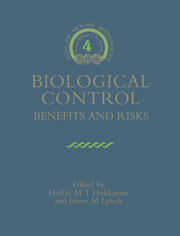Book contents
- Frontmatter
- Contents
- List of Contributors
- Series Preface
- Preface: Overview of Benefits and Risks of Biological Control Introductions
- Part I Biological Invasions
- Part II Classical Biocontrol
- Part III Augmentative Biocontrol
- 9 The Use of Exotic Organisms as Biopesticides: Some Issues
- 10 Use of Trichogramma in Maize – Estimating Environmental Risks
- 11 Entomopathogenic Nematodes in Biological Control: Feasibility, Perspectives and Possible Risks
- 12 Pseudomonads as Biocontrol Agents of Diseases Caused by Soil-borne Pathogens
- 13 Biological Control of Soil-borne Pathogens of Wheat: Benefits, Risks and Current Challenges
- 14 Genetically Engineered Fluorescent Pseudomonads for Improved Biocontrol of Plant Pathogens
- 15 Biological Control of Foliar Fungal Diseases
- 16 The Use of Fungi, Particularly Trichoderma spp. and Gliocladium spp., to Control Root Rot and Damping-off Diseases
- 17 Bacillus thuringiensis in Pest Control
- 18 Opportunities with Baculoviruses
- Part IV Use of Genetically Modified Organisms
- Part V Economics and Registration
- Index
10 - Use of Trichogramma in Maize – Estimating Environmental Risks
Published online by Cambridge University Press: 07 May 2010
- Frontmatter
- Contents
- List of Contributors
- Series Preface
- Preface: Overview of Benefits and Risks of Biological Control Introductions
- Part I Biological Invasions
- Part II Classical Biocontrol
- Part III Augmentative Biocontrol
- 9 The Use of Exotic Organisms as Biopesticides: Some Issues
- 10 Use of Trichogramma in Maize – Estimating Environmental Risks
- 11 Entomopathogenic Nematodes in Biological Control: Feasibility, Perspectives and Possible Risks
- 12 Pseudomonads as Biocontrol Agents of Diseases Caused by Soil-borne Pathogens
- 13 Biological Control of Soil-borne Pathogens of Wheat: Benefits, Risks and Current Challenges
- 14 Genetically Engineered Fluorescent Pseudomonads for Improved Biocontrol of Plant Pathogens
- 15 Biological Control of Foliar Fungal Diseases
- 16 The Use of Fungi, Particularly Trichoderma spp. and Gliocladium spp., to Control Root Rot and Damping-off Diseases
- 17 Bacillus thuringiensis in Pest Control
- 18 Opportunities with Baculoviruses
- Part IV Use of Genetically Modified Organisms
- Part V Economics and Registration
- Index
Summary
Introduction
Biological control of arthropod pests using arthropod natural enemies has been practised for centuries (Flint and van den Bosch, 1981), and although it has been widely appreciated that these natural enemies can have adverse effects on the environment, it has been largely assumed that they are either absolutely small or small relative to the benefits of biological control. For example, Samways (1988) suggested that there are no quantified cases where the introduction of an arthropod agent has been shown to have harmed a specific conservation programme or has been conclusively damaging to native fauna. This suggestion has proved difficult to test under natural conditions. For example, many natural enemies have been released to control forest Lepidoptera pests. Some of these enemies kill non-target, nonpest insects, and it has been suggested that such unintended mortality might destabilize these nonpest populations thus causing them to become sporadic pests. Recently, Pimentel et al. (1984) reviewed the evidence that biological control agents can cause adverse environmental effects. Their review clearly documented that biological control can entail environmental risk and that categorical dismissal of this concern is unwarranted. More recently, Howarth (1991) argued that the introduction of biological control agents into Hawaii and New Zealand is one of the major causes of extinctions of the native, insular, endemic arthropod faunae associated with these two islands. In most of those cases, vertebrate natural enemies were implicated, but Howarth (1991) developed a reasonable argument that arthropod natural enemies could also affect the native faunae.
- Type
- Chapter
- Information
- Biological ControlBenefits and Risks, pp. 101 - 118Publisher: Cambridge University PressPrint publication year: 1995
- 13
- Cited by



